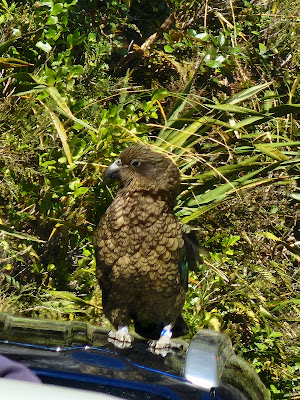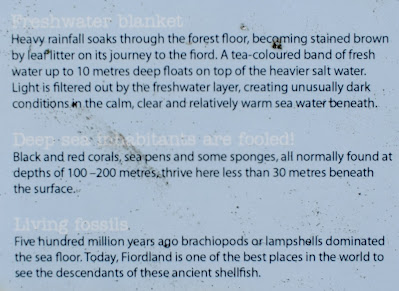 |
| Dang couldn't get into the driver's side of the car this morning. I managed to crawl in from the passenger side. The parking spots were very skinny at this hotel and the hotel was full. |
 |
| It was a cold morning, and I was glad I had packed my puffy coat. It might look a little funny, but it was warm. |
 |
| Map of the drive split between this photo and the next. |
 |
| Our first stop. |
 |
| That's a big knot. |
 |
| This stop did have information about the types of mistletoes that grow in New Zealand. |
 |
| We continued on our way and climbed higher into the mountains. |
 |
| Entering Homer Tunnel |
 |
| Looking back at the tunnel entrance and waterfalls coming down the mountains. |
 |
| One of the places we wanted to stop was fenced off. I think due to the possibility of an avalanche. |
 |
| Being the cheapskates that we are, we parked in the free lot a 20-minute walk from the cruise dock. The closer, but yet not close, parking lot costs $20. |
 |
| The trail started out a bit narrow but became boardwalk in some places. |
 |
| The narrator mentioned that the cruise line hired the best naturalist they could afford to talk to us about what we were seeing... Then he introduced himself as the narrator and captain of the boat. |
 |
| Twin waterfalls that we are going to approach. I think they are Fairy Falls and Bridal Veil Falls. |
 |
| The captain got the boat up really close to the waterfalls so we could see the rainbow. |
 |
| We sailed to the mouth of the sound but didn't venture out onto the Tasman Sea. |
 |
| The Māori name for Milford Sound is Piopiotahi |
 |
| Seal Rock is where the juvenile seals hang out. We did see a couple, but they are really hard to see in this photo. |
 |
| Hanging Valley waterfall |
 |
| The glacier on Mount Pembrook used to come down to the sound. This is one of the rare places in the world where a glacier abuts a rainforest. |
 |
| As we entered Harrison Cove, a crew member spotted a Crested Penguin so the captain sailed the boat up close to the shore so people could see it. |
 |
| This is Lady Bowen Falls. It is 162 meters (531.5 feet) high and is the water supply for Milford Village. |
 |
| Our cruise boat. There were a few boats at the docks but our boat was only about 10% full. There was a bigger crowd waiting at the dock when we got back. |
 |
| I'm so glad we were here early enough in the season that the sandflies hadn't emerged. |
 |
| A kea looking for food in a parking lot |
 |
| Fjordlands National Park. |
 |
| On the middle left of this photo, is Mitre Peak. It has a smaller, forested peak in front of it. At 5,560' it is the tallest sea mount in the world and falls over 3,000' straight down into the water. |
 |
| Plants I associate with warm weather with a glacier in the background. |
 |
| Don't know what this plant is but it is interesting how the leaves line up. |
 |
| Of course I had to pick up a rock. |
 |
| The abundance of ferns reminded me of the Pacific Northwest of the USA. |
 |
| We had to stop in order to take our turn going through the tunnel on the way back to Te Anau. |
 |
| I had read beforehand that we needed to watch for these cheeky parrots which would steal things from your car if you weren't careful |
 |
| One of the cars in front of us had attracted a parrot. |
 |
| Back through the long tunnel |
 |
| View at Monkey Creek |
 |
| Information panel at Pop's View |
 |
| View from Pop's View |
 |
| Māori names for various geographic features. |



























































No comments:
Post a Comment